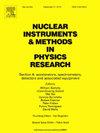基于MPRC-ToF的介子散射层析技术在不同场景下区分特殊核材料的理论时间成本
IF 1.4
3区 物理与天体物理
Q3 INSTRUMENTS & INSTRUMENTATION
Nuclear Instruments & Methods in Physics Research Section A-accelerators Spectrometers Detectors and Associated Equipment
Pub Date : 2025-04-29
DOI:10.1016/j.nima.2025.170557
引用次数: 0
摘要
μ介子散射层析成像(MST)是近年来备受关注的一种新型辐射成像技术,其研究方向分为快速检测和精细成像两个方向。越来越多的研究表明,充分利用μ子的动量信息对于两个方向都取得令人满意的结果至关重要。MRPC (Multi-gap Resistive Plate Chamber)探测器以其优异的时间分辨率和对带电粒子的高检测效率而闻名,广泛应用于高能物理实验的飞行时间(ToF)系统中。我们最近的研究表明,极窄间隙MRPC的时间分辨率可以达到16ps。因此,MRPC在需要考虑动量信息的μ子成像中具有很大的潜力。在本研究中,我们使用GEANT4工具包和ROOT的TMVA工具包,以快速检测为重点,在不同的背景条件下进行了详细的模拟,包括不同的体积、几何设置、材料、曝光时间和屏蔽方法。采用BDT、CNN、DNN等几种监督分类方法,以MRPC探测器为ToF获取μ子动量和真μ子动量,评估了MST系统对典型特殊核材料的快速响应能力。结果表明,使用CNN进行分类,基于MRPC-ToF的MST系统在45 s内的分类准确率达到92.8%以上,几何接受度为45.2%。当几何接受度为18.8%时,精度为81.26%,表明利用MRPC探测器作为ToF获取快速响应MST系统的介子动量信息是非常可行的。本文章由计算机程序翻译,如有差异,请以英文原文为准。
Theoretical time cost to distinguish special nuclear materials in different scenarios through MPRC-ToF based muon scattering tomography
Muon scattering tomography (MST), which has gained significant attention in recent years, is a novel radiation imaging technique evolving into two research directions: rapid inspection and detailed imaging. Increasing research shows that fully utilizing the momentum information of muons is essential to achieve satisfactory results for both two directions. MRPC (Multi-gap Resistive Plate Chamber) detectors are renowned for their excellent time resolution and high detection efficiency for charged particles and are widely used in Time-of-Flight (ToF) systems in high-energy physics experiments. Our recent research shows the time resolution of very narrow gaps MRPC can reach 16ps. Therefore, MRPC holds great potential in muon imaging where momentum information needs to be considered.
In this study, using the GEANT4 toolkit and ROOT’s TMVA toolkit, focusing on rapid inspection, we conducted detailed simulations under various background conditions, including different volumes, geometrical setups, materials, exposure time and shielding methods. We evaluated the rapid response capability of the MST system for typical special nuclear materials using MRPC detectors as ToF to obtain muon momentum and true muon momentum, applying several supervised classification methods like BDT, CNN and DNN. The results show that using CNN for classification, the MRPC-ToF based MST system can achieve an accuracy of over 92.8% within 45 s with a geometrical acceptance of 45.2%. When the geometrical acceptance is 18.8%, the accuracy is then 81.26%, which demonstrates that using MRPC detectors as ToF to acquire muon momentum information for a fast-responsive MST system is highly feasible.
求助全文
通过发布文献求助,成功后即可免费获取论文全文。
去求助
来源期刊
CiteScore
3.20
自引率
21.40%
发文量
787
审稿时长
1 months
期刊介绍:
Section A of Nuclear Instruments and Methods in Physics Research publishes papers on design, manufacturing and performance of scientific instruments with an emphasis on large scale facilities. This includes the development of particle accelerators, ion sources, beam transport systems and target arrangements as well as the use of secondary phenomena such as synchrotron radiation and free electron lasers. It also includes all types of instrumentation for the detection and spectrometry of radiations from high energy processes and nuclear decays, as well as instrumentation for experiments at nuclear reactors. Specialized electronics for nuclear and other types of spectrometry as well as computerization of measurements and control systems in this area also find their place in the A section.
Theoretical as well as experimental papers are accepted.

 求助内容:
求助内容: 应助结果提醒方式:
应助结果提醒方式:


